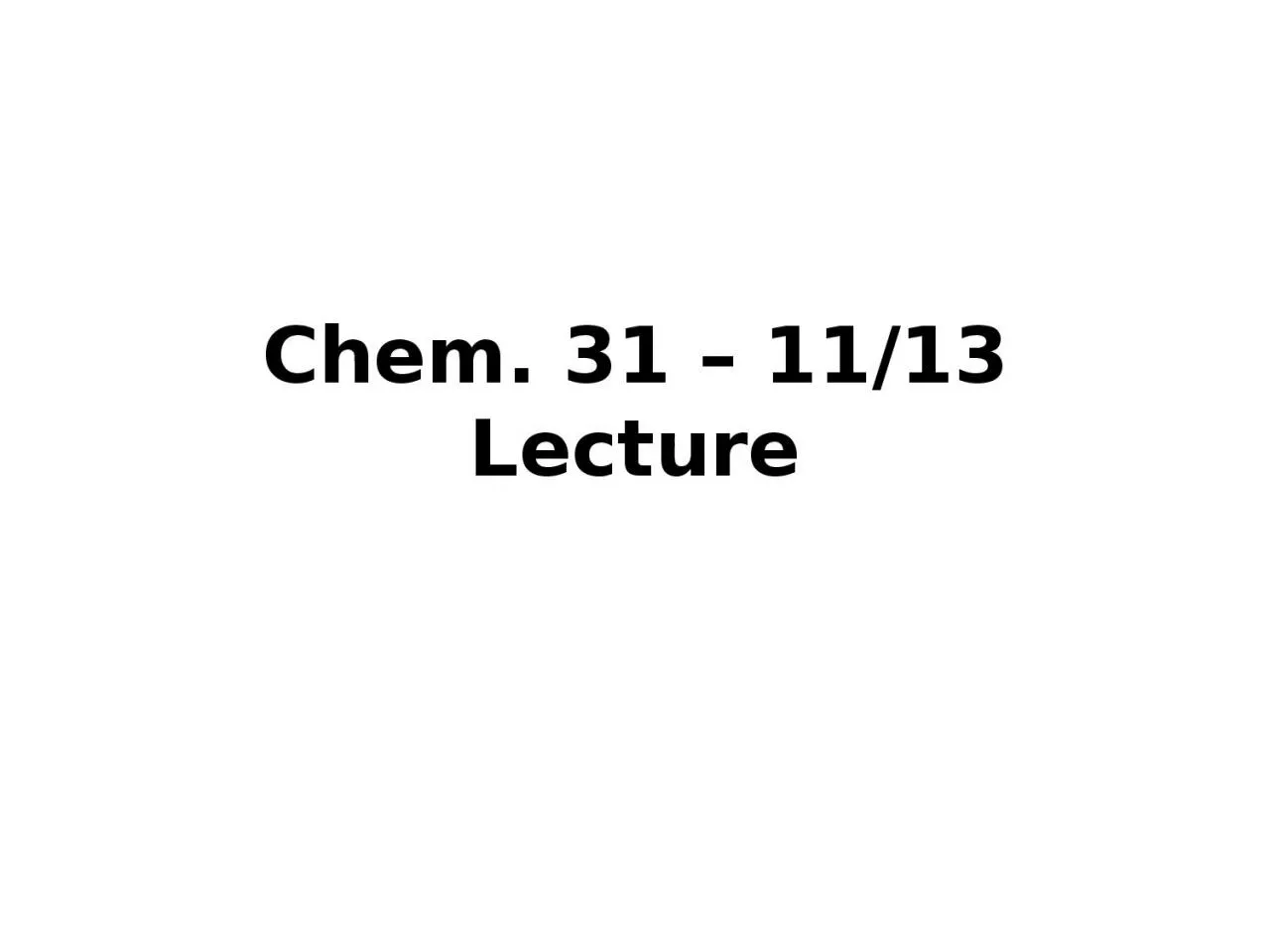

Announcements I CoCr Lab Report Due today Exam 2 Average was 78 still good Performance on multiple choice poorer Key your scores and overall lecture posted Announcements II New Homework Assignment to be posted soon ID: 1026549
Download Presentation The PPT/PDF document "Chem. 31 – 11/13 Lecture" is the property of its rightful owner. Permission is granted to download and print the materials on this web site for personal, non-commercial use only, and to display it on your personal computer provided you do not modify the materials and that you retain all copyright notices contained in the materials. By downloading content from our website, you accept the terms of this agreement.
1. Chem. 31 – 11/13 Lecture
2. Announcements ICo/Cr Lab Report – Due todayExam 2Average was 78% (still good)Performance on multiple choice poorerKey, your scores, and overall lecture % posted
3. Announcements IINew Homework Assignment (to be posted soon)Today’s LectureChapter 23 – ChromatographyRelative RetentionBand BroadeningResolutionChapter 8 – Advanced EquilibriumOverviewIonic Strength
4. Chromatography Definition Section – Relative RetentionFor a separation to occur, two compounds, A and B must have different k valuesThe greater the difference in k values, the easier the separationRelative Retention = a = kB/kA (where B elutes after A) = measure of separation ease = “selectivity coefficient” a value close to 1 means difficult separation
5. Chromatography Reading ChromatogramsDetermination of parameters from reading chromatogram (HPLC example) a (for 1st 2 peaks) = kB/ kA = tRB’/ tRA’ = (5.757 – 2.374)/(4.958 – 2.374) = 1.31
6. ChromatographyWhat do all these Parameters Mean? Relative Retention a values Can “adjust” value by choosing column (HPLC or GC) that is more “selective” for one compound than another or change the solvent (HPLC) to one which “dissolves” one compound better than anotherexample: on a non-polar column, diethyl ether (Kow = 6.8, bp = 34.6°C) and methanol (Kow = 0.15, bp = 64.7°C) are observed to partially co-elute giving a small a value.switching to a polar column will increase retention of methanol (stronger interaction with new column) and decrease retention of diethyl ether (weaker interaction with new column), increasing a.with HPLC, it is often possible to change the eluent to increase a. Recent example: reversed phase separation with acetonitrile and water lead to poor C16:0/C18:1 separation (for biodiesel characterization). Switching organic to methanol lead to improvement. [show on next slide]
7. ChromatographyWhat do all these Parameters Mean? Relative Retention a values – research example from last timeFatty acid separation example: - separating C16:0 (HO2C(CH2)14CH3) from C18:1 (HO2C(CH2)6CH=CH(CH2)6CH3) fatty acids with organic plus aqueous formic acidWhen using formic acid and acetonitrile, small a valueReplacement of methanol for acetonitrile improves a valueExample chromatogram – looks similar to this when used acetonitrile + formic acidC16 + C18:1Note: actually went to 14% FA(aq) /21.5% acetonitrile/64.5% methanol to decrease tailing with methanolC18:1C16
8. ChromatographyBand BroadeningBand Shape given by Gaussian DistributionGaussian DistributionNormal Distribution Area = 1Widthsσ (std deviation)w = 4σw1/2 = 2.35σGaussian Shape (Supposedly)2σInflection lineswHeightHalf Heightw1/2Will use most
9. ChromatographyColumn EfficiencyNumber of Theoretical Plates = N = Primary measure of “efficiency”N=1 corresponds to 1 liquid-liquid extractionGood efficiency means:Large N valueLate eluting peaks still have narrow peak widthsMinimal band broadeningN = 16(tR/w)2M (other multipliers with other widths)large N Valuelow N value
10. ChromatographyColumn EfficiencyRelative measure of efficiency = H = Plate height = L/N where L = column lengthH = length of column needed to get a plate number of 1Smaller H means greater efficiencyNote: H is independent of L (although usually calculated using L), N depends on LImprovement of EfficiencyIncrease column length (N = L/H) so doubled column length will have twice the N value (no change in H)Decrease H (use smaller diameter open tubular columns or smaller packing material) → greater N in same column lengthor
11. ChromatographyMeasurement of EfficiencyLater eluting peaks normally used to avoid effects from extra-column broadeningExample: N = 16(14.6/0.9)2 = 4200 (vs. ~3000 for pk 3)H = L/N = 250 mm/4200 = 0.06 mmW ~ 0.9 min
12. ChromatographyResolutionResolution = measure of how well separated two peaks areResolution = Δtr/wav (where wav = average peak width) (use this equation for calculating resolution)RS < 1, means significant overlapRS = 1.5, means about minimum for “baseline resolution” (at least for two peaks of equal height)
13. Chromatography Resolution ExampleRS calculation example:1st two retained peaks:tR(1st pk) = 8.20 min., w = 0.505 min.tR(2nd pk) = 9.09 min., w = 0.536 minResolution = 0.89/0.521 = 1.70Resolution not baseline due to peak tailingmannosan – 8.20 min.galactosan – 9.09 min.(Data from past student)main difference: axial – equitorial switch of 2 vs. 4 C OH groups is axial
14. ChromatographyOptimization – Resolution EquationHow to improve resolutionIncrease N (increase column length, use more efficient column)Increase a (use more selective column or mobile phase)Increase k values (increase retention)Which way works best?Increase in k requires no new column (try first) but it will require more time and will not work if kB is large to begin withIncrease N requires a new column (same type)Increasing a is the best but often requires a new column (different type).What if resolution is very good (e.g. = 5)?Can decrease k to have faster chromatogramReturned to text (not in 8th Ed.) B for 2nd component
15. ChromatographyGraphical RepresentationInitial SeparationSmaller H (narrower peaks)Larger k or longer column – Dt increases more than widthIncreased alpha (more retention of 2nd peak)
16. ChromatographyRecent Example95% organic/5% aqueous formic acid88% organic/4% aqueous formic acidImprovement due to greater retention
17. ChromatographyLast QuestionsA GC is operated close to the maximum column temperature and for a desired analyte, k = 20. Is this good?Two columns are tried for a GC separation of compounds X and Y. Both give initial resolution values of 1.2. Column A has a kY value of 0.8 while column B has a kY value of 5.0 (for 2nd eluting compound). Which column looks more promising?